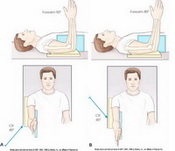IR Size: 8x10 TT
SID: 40''
• Hand supinated
• Elbow extended
• Pt. leans laterally
• Arm in same plane
• _|_Elbow Joint
•
• 3'' Proximal & Distal of elbow joint
•
• NR of Humeral epicondyles
• Slight SI of Radial head, neck, & tuberosity over Ulna
• Open Elbow Joint & Centered




IR Size: 8x10 TT
SID: 40''
• Elbow 90°
• Wrist Lateral
• Arm in same plane
• _|_Elbow Joint
•
• 3'' Proximal & Distal of elbow joint
•
• NR-Olecranon process in profile
• NR-Rad tuber facing Anterior
• Partial SI of Radial head & Coronoid
• Open Elbow Joint & Centered
• Elbow flexed 90°




IR Size: 8x10 TT
SID: 40''
• Arm extended, hand prone(=epi's will be 45° medial)
• Hand Prone
• Arm in same plane
• _|_Elbow Joint
•
• 3'' Proximal & Distal of elbow joint
•
• Coronoid process in profile
• NR-Coronoid process in profile
• SI of Ulna by radial head & neck
• Olecranon process within the olecranon fossa
• Trochlea clearly shown




IR Size: 8x10 TT
SID: 40''
• Arm extended
• Pt. leans Laterally
• Hand Supine 45°, (use 45° sponge)
• Digits 1 & 2 touching TT, =Arm in same plane
• _|_Elbow Joint
•
• 3'' Proximal & Distal of elbow joint
•
• Radial head, neck & tuberosity in profile
• No SI of Ulna by radial head, neck & tuberosity
• Capitulum clearly shown
• Open Elbow Joint & Centered




IR Size: 8x10 TT
SID: 40''
• Pronate t e hand and flex the elbow 90 degrees to show the adial head or 80 de~s to show the coronoid process
• Epicondyles should be approximately perpendicular to the IR.
• Slowly flex the elbow 90 degrees to show the radial head or 80 degrees for the coronoid process. Turn the hand so that the palmar aspect is facing medially. An assistant may need to hold the hand depending on the severity of trauma
• Enters Elbot Joint
• For Radial head-45° cephalad to radial head; For Coronoid process-45° caudad to coronoid process
• 3'' Proximal & Distal of elbow joint
•
•
• For Radial head - Open radial head & capitulum joint
• Profile radial head, neck, & tuberosity without SI, excep a small portion of the coronoid process
• Humeral epi's distorted from central ray angulation & Radial tuberosity facing posteriorly
• Elbow flexed 90 degrees
• For Coronoid Process - Open joint space between coronoid process & trochlea
• Coronoid process in profile & elongated, • Radial head & neck superimposed by ulna, • Elbow flexed 80 degrees



